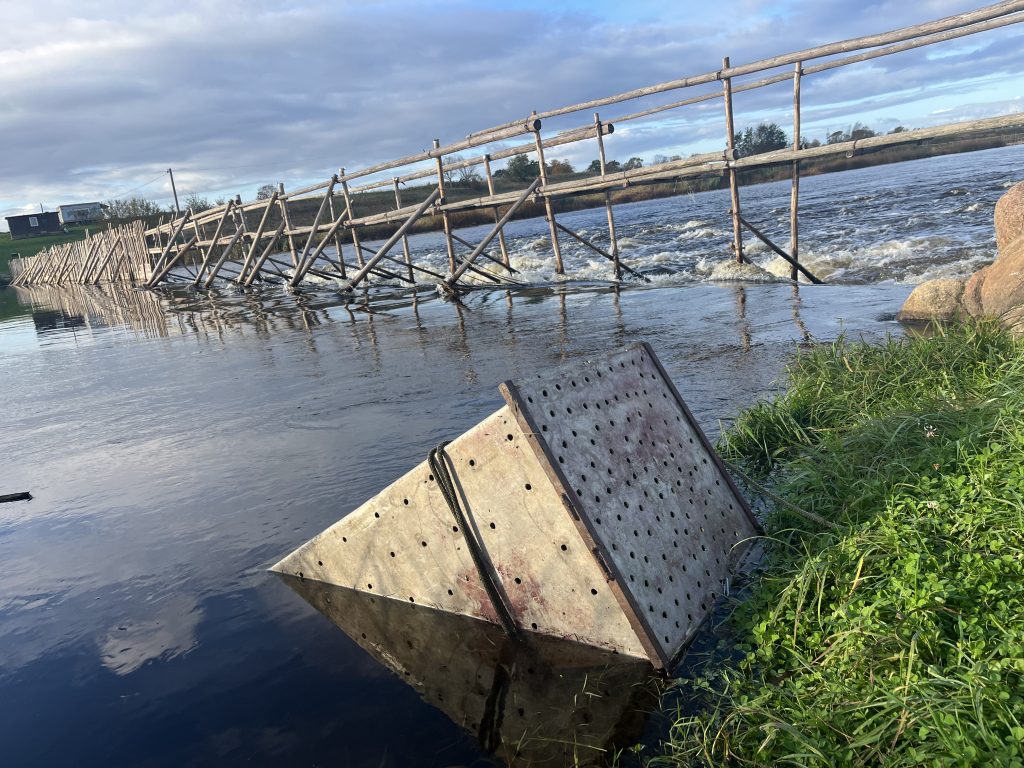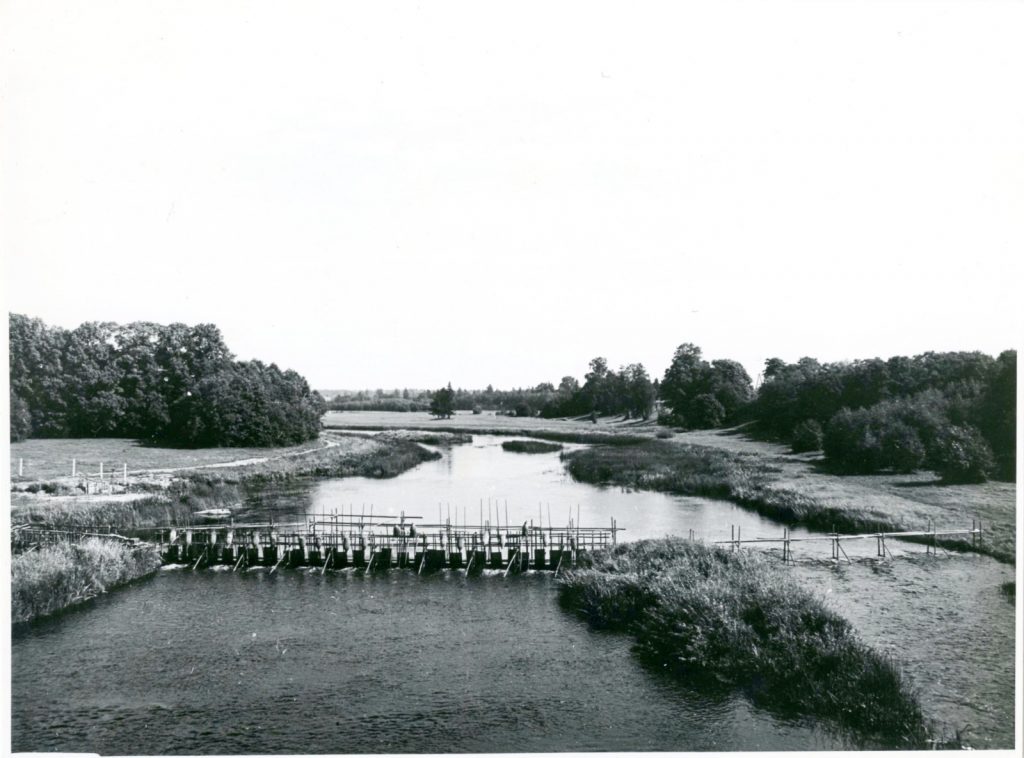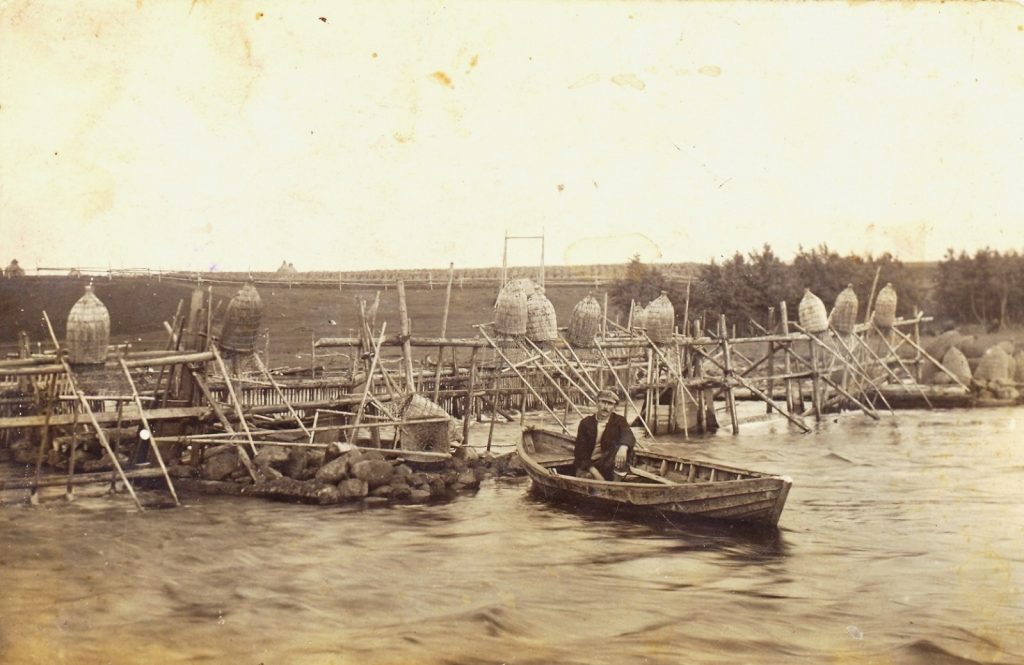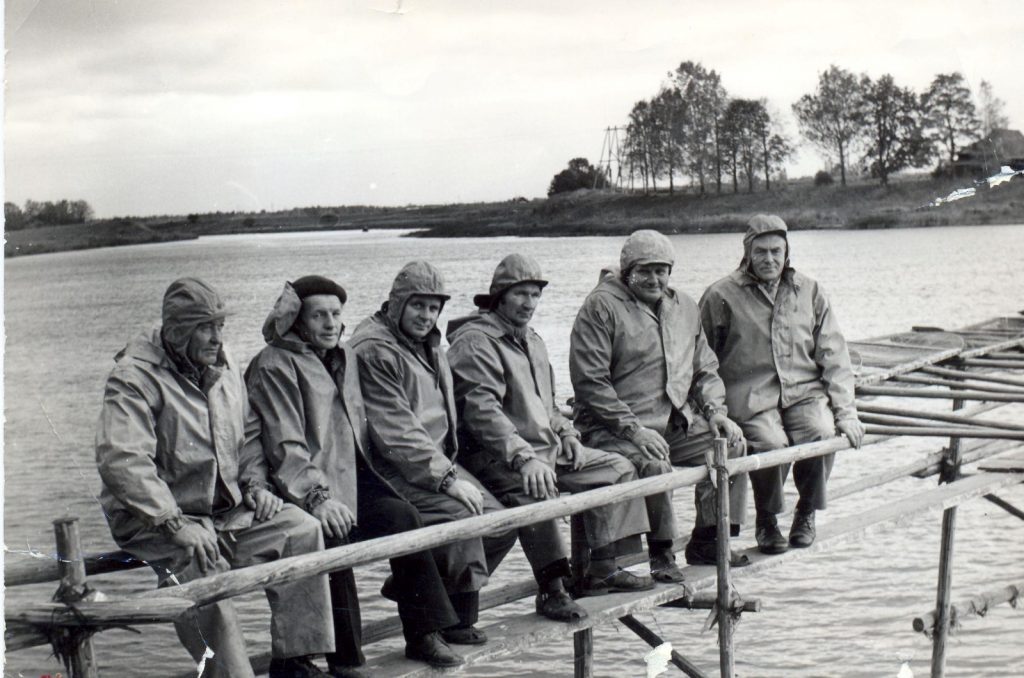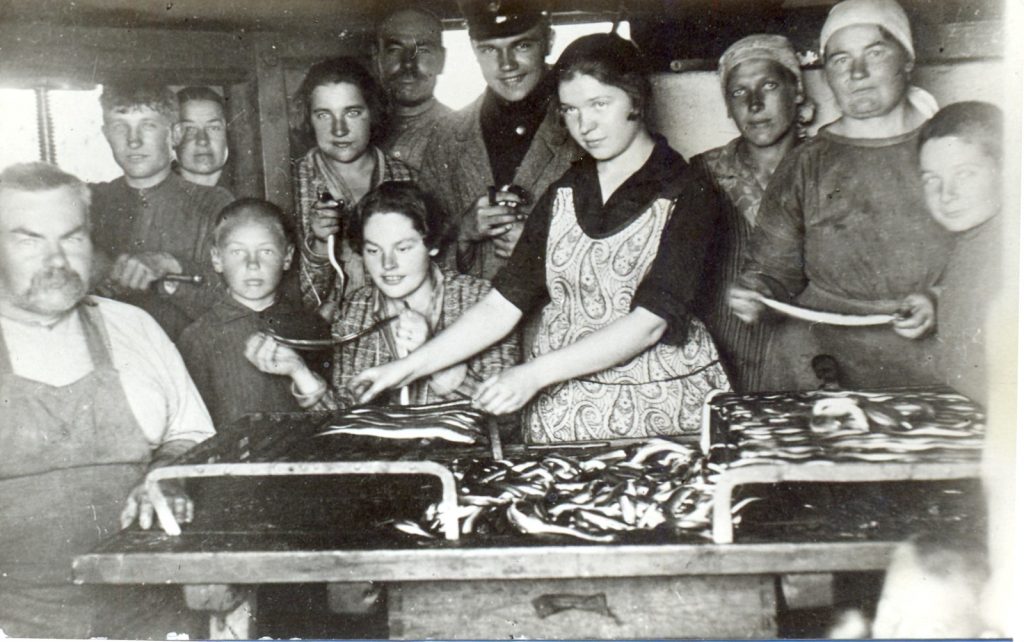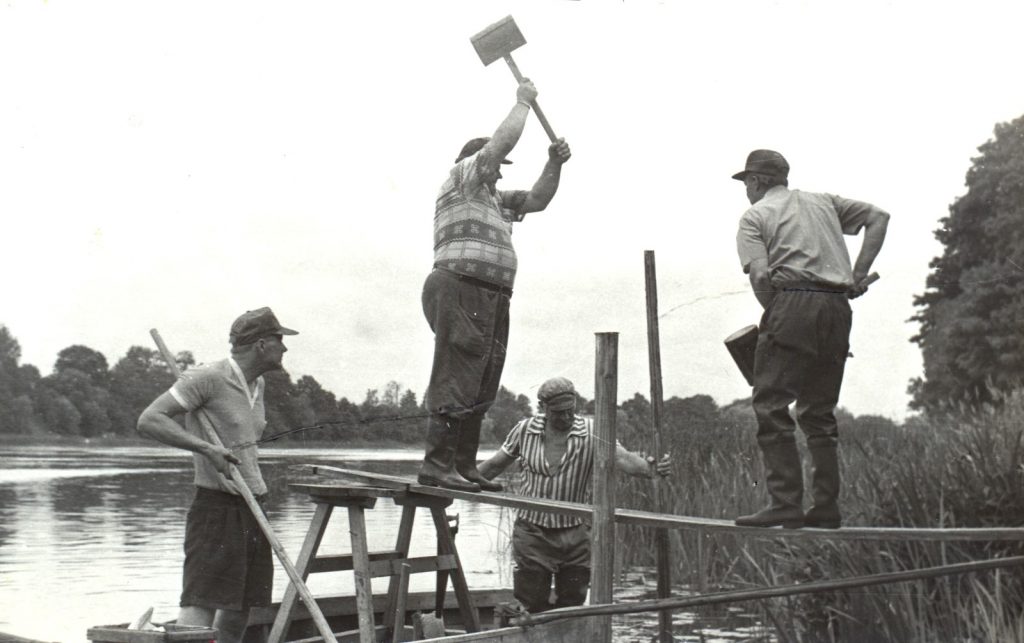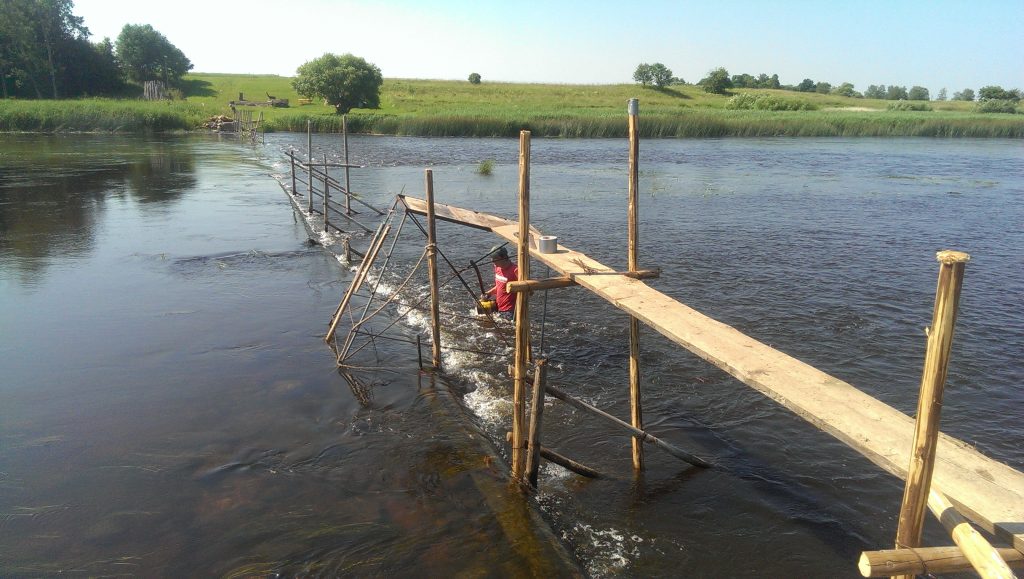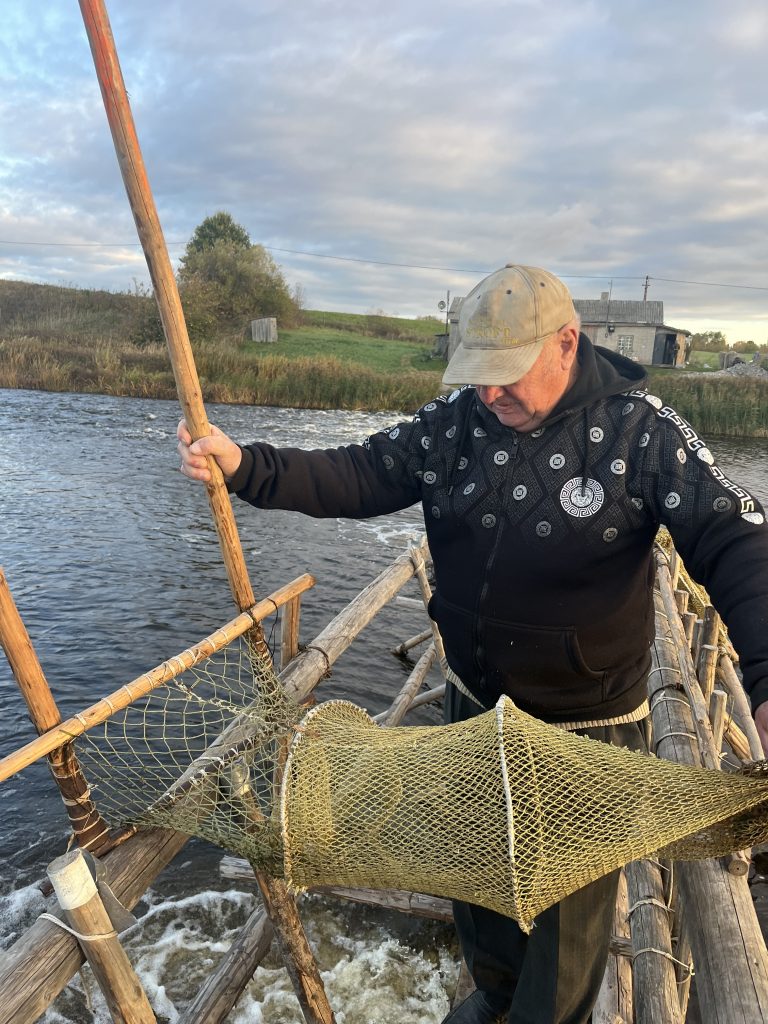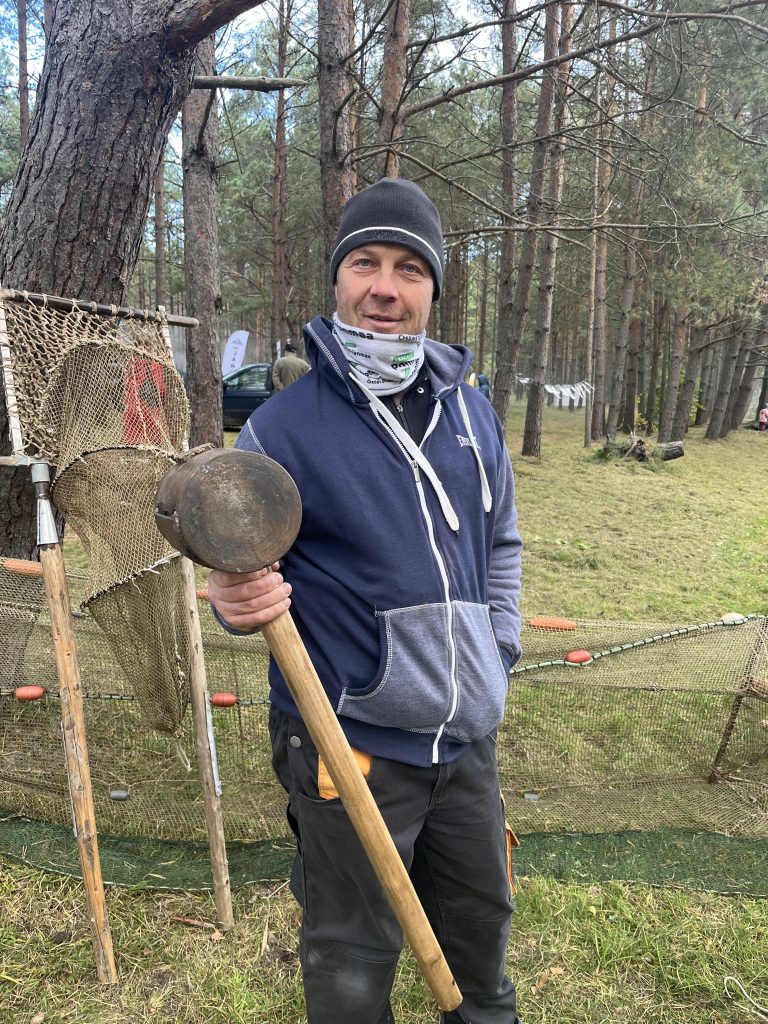Author:
Ieva Vītola, dr. art., tradicionālās kultūras pētniece
Traditional kitchen
Traditional craft skills
Knowledge and practices concerning nature and the universe
Title
Lamprey fishing in the Salaca and Svētupe rivers (2025)
In the past, the lampreys found on the banks of the Salaca and Svētupe rivers were also known as zutiņi (‘little eels’), but now only a few locals are aware of this name. Those caught in these rivers are now more commonly known as Salacgrīvas nēģi or Salacas nēģi, meaning ‘Salaca lampreys’.
The river lamprey, or Lampetra fluviatilis, usually grows to around 50 cm in length. It has a snake-like body without scales, three eyes, seven gill openings and a sucker-like mouth. River lampreys live in the sea, but spawn in rivers. On average, the life cycle of a river lamprey is seven years, 3–6 of which are spent in the larval stage. During this time, lamprey larvae, or ammocoetes, live buried in the riverbed. Once they have grown, they migrate to the sea, where they remain for 1–3 years before returning to the rivers to spawn. After spawning in the spring in the rapids of the rivers, the lampreys die.
Geography
Salaca and Svētupe, Salacgrīva, Svētciems, Limbaži District
The core of the heritage community consists of 10–15 lamprey fishermen who work or have worked on three weirs in the Salaca River and one in the Svētupe River. They are united by their inherited lamprey fishing skills, which are used not only during the lamprey fishing season, from August to February, but also when preparing the weirs, which are set up anew each year across the Salaca and Svētupe rivers.
These skills are passed down from generation to generation within a small circle, usually among close relatives (fathers to sons and/or grandsons, fathers-in-law to sons-in-law, and so on).
Lamprey fishermen are local men born in Salacgrīva or the surrounding area who still live and work there. They also have their own language, with specific vocabulary relating to tools, boat construction, and so on. (see Appendix).
Salacgrīva and the surrounding area are also home to several entrepreneurs and home producers, including lamprey cooks who prepare lampreys caught in the Salaca and Svētupe rivers. There are also several entrepreneurs and home producers in Salacgrīva who process lampreys caught in the Salaca and Svētupe rivers and sell them to other lamprey lovers.
More broadly, the tradition of fishing for and consuming lampreys in Salacgrīva and Limbaži County is characteristic of Northern Vidzeme as a whole. This tradition shapes the identity of Salacgrīva, the Salaca and the Svētupe rivers, and is important to local residents as lampreys are a delicacy served at festive occasions such as the national holiday on 18 November, Christmas, and New Year’s Eve.
Every year in October, Lamprey Day is held on the banks of the Salaca and Svētupe rivers. This popular event, or ‘meeting festival’, attracts both local residents and visitors from further afield and abroad.
Lamprey traditions are also evident in Salacgrīva’s cultural landscape, reflected in names of places where the weirs are placed and various local cultural activities. For instance, the Salacgrīva literary almanac Zutiņš has been published since 2020. The Salacgrīva Tourism and Information Centre provides information about river lampreys and lamprey images are often used on souvenirs.
Significance in community life
As lampreys are only fished in a few Latvian rivers (mainly the Salaca, Gauja, Daugava, Venta and Saka), and there are few lamprey fishermen, this profession has a prestigious status, as lampreys are becoming scarce and expensive. As Ainārs Duncītis, a lamprey fisherman from the Salaca River, says, ‘The prestige comes from the fact that lampreys are rare and they fetch quite a price. They are an expensive, rare commodity. You can get brisling sardines anywhere! But where can you get lampreys? In the Salaca and a few other rivers in Latvia. So it’s like – wow!’
Moreover, being a lamprey fisherman is a privilege – fishermen sign an industrial fishing rights lease agreement (usually for up to 15 years) and purchase a licence each year. This licence can only be revoked ‘in the event of a violation, unless one refuses it oneself’.
Lamprey fishermen are also united by the fact that lamprey fishing still uses the ‘old method’ passed down from their ancestors, with no new inventions. Nowadays, lamprey fishing with weirs has only survived in Latvia in the Salaca and Svētupe rivers. This is a source of pride for the heritage community: ‘The way they fish in the Salaca, they don’t fish anywhere else anymore!’
In the past, lamprey weirs were also used in the Gauja River. Today, however, due to changing conditions, fishermen in Carnikava catch lampreys in the lower reaches of the river using pots and driving long wooden stakes, known as bostagi, into the riverbed.
Find out more at https://nematerialakultura.lv/Elementi/negu–kersanas–un–apstrades–prasmes–carnikava–2019/.
In other Latvian rivers, lampreys are mainly caught with pots or other fishing gear. However, only in the Salaca and Svētupe rivers are lampreys caught with pots and baskets (puņģi) using a special weir construction.
Activities
In the Salaca and Svētupe rivers, two methods are employed in the lamprey weirs: pots (Salaca No. 1 weir and Svētupe weir), into which the lampreys swim of their own accord; and with puņģi or the so-called ‘drop’ method (Salaca No. 2 and No. 3 weirs, as well as the Svētupe weir), where the river current is regulated by weir slides or water gates. The lampreys attempt to overcome these, but usually fail, and the current sweeps them into the weir or pot, also known as a kuloks. As lamprey fisherman Visvaldis Šrenks, owner of the weir No. 2, explains: ‘In the pot, the lamprey swims on its own; in the puņģis, the lamprey is thrown in by the current. The lamprey swims upwards towards the spawning grounds. It cannot resist the current and drops back. So, lamprey fishermen catch the lampreys by fooling them.’
Lamprey fishing takes place in two-thirds of the river; one-third is left to the free flow of the current to ensure the preservation of the lamprey population. At the Svētupe weir, fishing is permitted with one basket and one pot; at the Salaca weir No. 1 (150 m long), with 80 pots; at weir No. 2 (78 m long), with 30 baskets; and at weir No. 3 (76.6 m long), with 25 baskets.
‘Putting in a pot and pulling it out – that’s not lamprey fishing,’ says Aleksandrs Rozenšteins, a lamprey fisherman and the owner of the Salaca weir No.1. Lamprey fishermen must also know how to mend and repair the pots, and most importantly, how to build a weir: a special lamprey fishing structure built from peeled spruce branches without a single nail, only wire.
When the fishing season ends on 1 February, lamprey fishermen begin preparing for the next season. They go to the forest, cut down spruce trees or buy them already cut, bring them home in the spring, peel them, and dry them. Spruce is chosen for lamprey weirs because it is the most durable, and its straightness and length make it best suited for poles of various sizes and functions.
Construction of the weir usually takes place during the summer months, when the water level is low. The weir structure is then built in the water using a 16 kg wooden mallet, or kurķis, to drive stakes into the riverbed and prepare the weir sections (kraķi) one by one. To make the weir more durable and flexible, nails and screws are not used in its construction; the elements of the weir are held together solely by wire. The weir is rebuilt every year as it is usually washed away by the river and into the sea. Only the base (‘sole’) of the structure remains in the riverbed. Building the weir takes a whole month of hard work. Once the weir is ready, planks 30–40 cm wide are laid across the entire width of the river so that people can walk along it.
Lamprey fishing is hard work – it takes place at night, from dusk till dawn. From August to February, they spend their nights in weir huts or cars on the riverbank because they have to periodically go out onto the narrow, icy footbridge over the strong river current to check the baskets and pots for lampreys, and to see if grass and leaves in autumn or ice floes are not jamming up in winter, which puts pressure on the weir structure. Sometimes, they must protect the weir from trees, branches and stumps carried by the river. As Visvaldis Šrenks says, ‘If necessary, you can walk along the weir ten times a night, other times just once is enough.’ When working, fishermen wear waterproof work clothes and gloves, as well as rubber boots.
The best catches are usually made in bad weather conditions when it is cold, raining and windy outside, as this is when lampreys are most likely to travel upriver to their spawning grounds. Nikolajs Koluškins, a lamprey fisherman from Svētupe, has observed: ‘The worse the weather is for humans, the better it is for lampreys.’ Lamprey fishing also takes place when the river is frozen over – fishermen cut holes in the ice and fish underneath it.
Lamprey fishermen have no holidays or days off during the season: ‘You have to go and work.’ Therefore, a special fondness for the work is required – lamprey fishermen are united by the fact that ‘this work is in their hearts’. Mārtiņš Bahmanis, a lamprey fisherman in his second season, says, ‘You have to like this work. Not everyone is ready to do it. There are many weeks when you don’t get paid – you work for free.’ Jānis Krūmiņš, the youngest fisherman and now in his third generation in his native village, says, ‘You can’t expect the lampreys to crawl into the box by themselves!’
The work of lamprey fishermen is affected by unpredictable weather conditions, such as ‘the wrong winds’ – only west, north-west and north-south winds are suitable for lamprey fishing in the Salaca and Svētupe rivers, while east winds are completely unsuitable. Similarly, heavy storms at sea cause high water levels in the Salaca and Svētupe rivers, turning them into ponds and causing flooding around the weirs, which allows ‘the lamprey to swim upstream without any problems’.
Lamprey fishing is a game of chance where the results are seen in the morning when the pots or baskets are lifted one by one, with the catch being carried over the shoulder to the shore. The nets must be only half full; otherwise, the lampreys will escape and even get behind one’s collar. In one night, you can catch anything from 10 lampreys to a whole tonne. In the Salaca River, an optimal catch is considered to be around 100 kg, while in the Svētupe River, a good catch is considered to be around 50 kg of lampreys.
Beliefs, rituals, and unwritten rules
There are certain unwritten rules and beliefs among lamprey fishermen. One of these is, ‘The most important thing when going to the weir is to keep your hands out of your pockets – that’s the golden rule!’
Although not documented anywhere, lamprey fishing is organised at weirs No. 2 and No. 3 of the Salaca River. As there are four fishing rights/licence holders on each of these fishing grounds, work is organised according to a schedule or in shifts, with each person working every fourth night. Similarly, work and financial resources are shared in the construction of the weir.
Passing on and transferring skills
Learning lamprey fishing skills is limited. It can only be learnt through experience, by observing and learning from more experienced fishermen who have inherited their knowledge and skills from previous generations. Mārtiņš Bahmanis, who became a lamprey fisherman relatively recently, says, ‘You can’t just decide you want to catch lampreys. You get to work on the weir, either by inheriting it or by marrying into it.’
Family ties and lamprey fishing rights determine the narrow circle of skill transfer as these rights are limited in number: one on the Svētupe weir; one on the Salaca No. 1 weir and four each on the Salaca No. 2 and No. 3 weirs. Legislation stipulates that, provided there have been no violations, fishing rights are granted or extended for the longest period – up to 15 years.
Members of the public can learn about the skills and traditions associated with lamprey fishing at the Salacgrīva Museum, where part of the exhibition is dedicated to ‘Zutiņš murdā’ (‘Little Eel in the Pot’), i.e., to Salaca lampreys and their fishing. Various publications, such as the Lamprey Bible published in 2022, as well as television and radio reports, promote this Salacgrīva tradition. The annual Lamprey Day and a special offer for school and adult groups at Salaca No. 1 weir during the first three months of the lamprey season also help people to explore and discover this unique craft.
History
Lamprey fishing and techniques using pots and baskets in the Salaca and Svētupe rivers have a long history. While detailed historiographical research has yet to be conducted, it is known that traps and the associated stone islands in the Salaca River near Vecsalaca Manor have existed since at least 1690 (Cimermanis, 2020). Documentary evidence in the Latvian State Historical Archives (LVVA 7404.f.1.apr.1418.l.) also confirms this.
A drawing by Johann Christoph Brotze from 1780 also depicts a weir on the Salaca River near Vecsalaca, which was likely used for catching lampreys, if not salmon. The antiquity of these fishing traditions is also evidenced by several Somugrian words, most likely originating from the Vidzeme Livonian language, that are still in use among lamprey fishermen, such as puņģis, murds, and kurķis.
Archival documents used in publications by R. Noriņa and S. Cimermanis (Cimermanis, 2020; Noriņa and Kursīte, 2016) confirm that there were several weirs on the Svētupe and Salaca rivers, which were used by local farmers to fish for lampreys. In the 1930s, the Ungurs weir was located on the Salaca, alongside Aleksandrs Greilihs’s double weir with a salmon fence and another weir at the Vecsalaca manor (see Salacgrīvai 80, 2008).
During the Soviet era, lamprey weirs were managed by the Brīvais Vilnis fishing collective. There was one on the Svētupe, one on the Jaunupe (the canal connecting the Svētupe and Salaca rivers), and at least five on the Salaca – in addition to the ones existing today, there was one above and one below the Vecsalaca bridge. One of these, weir No. 4 downstream from the bridge, was known as the Kungu weir: the collective farm’s guests were taken there to feast on fried lampreys.
During the collective farm era, the best catches were made at weir No. 2. The weirs were operated by the collective farm’s fishing brigades: No. 1 and No. 2 were served by a special lamprey fishing brigade, and No. 3 by a coastal fishing brigade. In the 1980s, the No. 1 weir of the Salaca River belonged to the Salacgrīva City Executive Committee, while Nos. 2 and 3 belonged to the Vecsalaca Village Council. The fishing collective farm Brīvais Vilnis acquired the rights to fish in the lamprey weirs at auction.
When the economic crisis hit in early 2000, severely affecting fish sales in Russian markets, the company decided to give up the weirs and offer them to the local lamprey fishermen. Thus, individual fishing resumed in the lamprey weirs. The Rozenšteins family took control of No. 1, the brothers Bruno and Visvaldis Šrenks, Juris Jēkabsons, and Ainars Duncītis took over No. 2, and Captain Jānis Krūmiņš got No. 3. The lamprey weir on the Svētupe River was restored in 2006 and is now managed by the Koluškins family. The previous weir, which was used during the Soviet era, was located a hundred metres upstream.
Since 2022, Salacgrīva lampreys have been included in the European Union’s Register of Protected Designations of Origin and Protected Geographical Indications. This guarantees the quality and reputation of the product and provides financial support for lamprey fishermen and processors.
As lamprey fishing relies on the river lamprey (Lampetra fluviatilis), the decline in lamprey populations in the Baltic Sea region over the last decade has brought the issue to the attention of nature conservation and research bodies, particularly the Nature Conservation Agency and the BIOR, the Scientific Institute for Food Safety, Animal Health, and Environment, and it has become the focus of their work.
Today, lamprey fishing techniques have remained practically unchanged. As the fishermen put it: ‘Nothing new can be invented here; everything has already been tried and tested.’ However, some contemporary technological innovations have been introduced over time. For instance, lamprey weirs are now tied with iron wire rather than steamed spruce bark; pots and baskets used to be woven from spruce branches, but nowadays they are made of nylon mesh. The vessel that fishermen used to carry lampreys to shore used to be made of wood, but is now made of a lighter material such as aluminium or plastic. The work of lamprey fishermen is now made easier at night by headlamps and night cameras, which allow fishermen and their assistants to observe the river from the warmth and dryness of their huts. Lampreys are no longer sold by the kāls (a score and a half, i.e., 30 lampreys), but by the kilo.
The lamprey weirs in the Salaca and Svētupe rivers have now become tourist attractions. At the start of the lamprey season, the Salaca No. 1 weir is open to visitors. Aleksandrs Rozenšteins, the owner, talks about river lampreys and fishing traditions in the Salaca region and offers tastings of freshly fried lampreys.
Throughout the ages, lampreys have continued to represent Salacgrīva. In the past, visitors were welcomed at the Kungu weir, but today it is the lampreys themselves that welcome visitors. Fried Salaca or Svētupe lampreys in jelly, packed in boxes or jars, are a special delicacy with which to treat guests or take home as a gift.
Additional Information
LANGUAGE AS A FORM OF LIVING HERITAGE
Lamprey fishermen have their own vocabulary, passed down from previous generations, which is still used in their daily work: sist/klopēt taci, soga, ķērne, kumma, tača acs, kurķis, and so on, as well as good-luck expressions (often expressed in the negative), such as Ne hordas!, Līdz rītam!, Jāiet uz veikalu un jāparegulē laiku!, Krītamtiesu jau dabūs!, etc. In the past, and sometimes even nowadays, lampreys were called zutiņi on the banks of the Salaca and Svētupe rivers. See the appendix for a collection of words and expressions used by lamprey fishermen!
Some lamprey fishermen have developed their own repertoire of stories for visitors, including personal anecdotes, tales about river lampreys and their appearance, and social stereotypes about lampreys.
OBSERVING THE WEATHER, KNOWLEDGE ABOUT NATURE AND THE UNIVERSE
As lamprey fishing depends on luck and natural conditions such as the river’s hydrological situation, lamprey fishermen are also skilled observers of nature. However, they are well aware that ‘nature is as nature does’. For example, if an easterly wind blows, fishermen know that there will be no lampreys, and if it is a clear night with a bright full moon, they will most likely not catch anything because lampreys dislike light. Lampreys also dislike snowmelt and ice floes. The best catches are made when the prevailing wind is westerly or a sea breeze and the river water is not too warm.
Lamprey fishermen also observe the behaviour of the river, such as the water level and current, as this informs their fishing strategy. Similarly, in autumn, after the first frosts and cold spells, there is much more grass in the river, so you have to inspect your weirs more often.
Fishermen have made many observations about the behaviour of lampreys and share their knowledge. For example, they have noticed that, at the end of autumn, the river water tends to turn ‘tea-coloured’ and ‘bitter’ from the falling leaves. This may affect the lampreys because they cannot sense the enzymes secreted by the ammocoetes that cause them to spawn in the river. Conversely, when the west wind blows and the lampreys begin their spawning journey, they tend to come in schools, locally known as ploce (plote or pote). This means that at least three consecutive nights could be productive, although a good catch is not guaranteed. First, there will be smaller lampreys; then, on the second night, larger ones in greater numbers; and finally, on the third night, both large and small ones, albeit in smaller numbers. “Pote is when there is a good lamprey run. The lampreys then come for three or four days. That’s when the sea wind blows, lifting the water in the river. Then it calms down and the lampreys come in to spawn,’ says Jānis Krūmiņš, sharing his experience.
Working on and by the river and always in tune with nature, fishermen can also recount various observations related to animal behaviour. Aleksandrs Rozenšteins has noticed that if the meadow near his house is full of seagulls, then it’s clear that there will be wind the next morning or evening at the latest: ‘It’s as if they can sense it. The sea is already opening up!’ If crows appear around the fishing hole, a thaw is expected. ‘When crows start walking along the water’s edge, it’ll be above zero. If sparrows start chirping, there will also be a thaw,’ Aleksandrs continues. Jānis Krūmiņš remembers what he has heard: ‘They say that if there are many ducks living on the river, then there are lampreys. But lampreys come at night and ducks are there during the day. What’s then the relationship? The answer is that when small fish are caught in pots, there are no lampreys.’
CRAFTSMANSHIP SKILLS
Every lamprey fisherman knows how to maintain his fishing gear, such as repairing pots and small pots (puņģi) and mending nets. They put these inherited skills to use every day: ‘There must be a shuttle for every weir.’
The use of nylon nets for pot-making only began in the 1990s; until then, both pots and puņģi were woven from spruce twigs. For several centuries, gathering twigs and weaving fishing gear was an important occupation and source of income for families living on the banks of the Salaca and Svētupe rivers. The Salacgrīva Museum has evidence of twig deliveries in the mid-19th century and several ethnographic objects for weaving fish traps. There may still be people in Salacgrīva and the surrounding area who know how to weave fish traps from spruce twigs. Nowadays, lamprey fishermen either weave fish pots and puņģi themselves or order them from other fishing gear makers.
CULINARY HERITAGE
Culinary heritage skills and recipes are also associated with lamprey fishing. Although lamprey fishermen do not process their catch themselves, selling it instead to buyers or lamprey cooks, each of them knows how to cook lamprey: ‘We fry lampreys ourselves in our huts!’ Each hut has a stove similar to a bread oven which is heated with coarse birch or alder wood to produce large coals. While it is heating up, the lampreys are arranged on the racks back to back, with their heads and tails next to each other. The lampreys are pressed beforehand by placing them in a sack and putting a weight on top because ‘you can’t cook them alive; they keep wriggling’.
Once roasted, the lampreys must be monitored closely – they are ready when the skin begins to crack slightly. Lampreys are eaten either freshly cooked or in jelly. In Salacgrīva and the surrounding area, families, home producers and lamprey processors favour two methods of preparing lampreys in jelly. One method involves wrapping the fish in wax paper after frying and keeping them under a warm blanket for about an hour and a half until they are warmed through. They are then pressed or squeezed to extract the juice. Afterwards, the lampreys are layered in a vessel, and cooled salt water, to which gelatine may be added, is poured over them. The second method involves placing the lampreys, which have been roasted on charcoal, in a pot and simmering them for half an hour to soften them up. Then, salt water mixed with gelatin is poured over them.
Lampreys are not an everyday food. Due to their seasonality and high price, they have always been considered a delicacy.
CELEBRATIONS
Lamprey fishermen tend to mark the beginning of the lamprey season. While the end of the season is unpredictable due to the unpredictability of the river, weather and how long the weir will remain in the river, the start of the season is predictable – it is always 1 August and is usually celebrated like New Year’s Eve. In the past, on the evening of 31 July, fishermen would gather with their families and neighbours, sit down and set the table. At midnight, they would set off fireworks and go to the river to set up their pots or puņģi. In recent years, however, the opening of the season has declined for various reasons, including mutual disagreements, a ‘lack of enthusiasm’, and a poor previous fishing season.
Nowadays, lamprey fishermen consider Lamprey Day to be the main celebration of their work, when each fishing spot hosts some kind of event involving families, friends, neighbours and invited guests.
Masters
There are several knowledgeable and practising lamprey fishermen in Salaca and Svētupe:
• Aleksandrs Rozenšteins (Salaca weir No. 1);
• Uldis Rozenšteins (Salaca weir No. 1);
• Māris Klētnieks (Salaca weir No. 1);
• Visvaldis Šrenks (Salaca weir No. 2);
• Bruno Šrenks (Salaca weir No. 2);
• Gunārs Zvejnieks (Salaca weir No. 2);
• Ainārs Duncītis (Salaca weir No. 2);
• Mārtiņš Bahmanis (Salaca weir No.2);
• Jānis Krūmiņš, Jr. (Salaca weir No. 3);
• Jānis Krūmiņš Sr. (Salaca weir No. 3);
• Māris Krūmiņš (Salaca weir No. 3);
• Jānis Celmiņš (Salaca weir No. 3);
• Jānis Rakuzovs (Salaca, weir No. 3);
• Armands Persidskis (Salaca, weir No. 3);
• Jānis Žurakovskis (Salaca weir No. 3);
• Nikolajs Koluškins (Svētupe weir).
Agencies and institutions
Lamprey fishermen organise their work through various business structures:
• Salaca weir No. 1: Kurķis fishing farm (A. Rozenšteins);
• Salaca weir No. 2: Lucītis 2 general partnership, combining the following companies: Bute fishing farm (V. Šrenks), SIA Salacas nēģis (A. Duncītis), IK Mednieks, Upenieki farm (G. Zvejnieks), ZS Abi Pluss (B. Šrenks);
• Salaca weir No. 3: Tacis general partnership, comprising the companies Aļģes-1 (J. Krūmiņš), Rhodeus (J. Celmiņš), and Gobulauki (J. Rakuzovs);
• Svētupe weir – J.A.N.K.I. individual business (N. Koluškins).
In 2018, lamprey fishermen from the Salaca and Svētupe, along with the companies that represent them and lamprey processing companies such as SIA Kurzeme GB and SIA Zivju kiosks, formed the Salacgrīvas nēģi association.
The Limbaži District local government institutions, the Salacgrīva Museum, and the Tourist Information Centre, are actively involved in preserving and promoting the living heritage of Salacgrīva.
Consolidation
To date, the lamprey fishermen themselves, the Salacgrīvas nēģi association, the Salacgrīva Museum, and the local government have been involved in preserving lamprey fishing traditions by implementing various projects and organising events.
For example, in 2002, when the European Heritage Days were dedicated to industrial heritage, the Salaca weir No. 2 venue received the European Heritage Flag, which became a part of the collection of the Salacgrīva Museum.
In 2009, the Salacgrīva Museum created an exhibition entitled ‘Zutiņš murdā’ (Lamprey in the Trap), revealing the history, techniques, and fishing gear used for lamprey fishing in the Salacgrīva area. Together with Pēteris Mežulis, museum staff have also created a short film about lamprey weirs and fishing entitled "No egles līdz tacim" (From Spruce to Weir), which can be viewed at the museum. With the support of the State Culture Capital Foundation, a digital exhibition entitled ‘Salacgrīva Museum Treasures’ has also been created, one section of which is dedicated to the lampreys of the Salaca. Since 2024, the museum has had a new exhibition entitled ‘Lībiskā piederība’ (Liv Heritage), which includes a section on lamprey weirs and fishing in the Salaca.
The Limbaži District Municipality, specifically the Salacgrīva Tourist Information Centre, has played a key role in promoting this tradition by organising Lamprey Day every October. On this day, lamprey fishing and lampreys are honoured on the banks of the Salaca and Svētupe rivers, with lamprey fishermen, the Salacgrīva Museum, the Latvian Rural Education and Consultation Centre and local entrepreneurs participating in the organisation of the event.
On Lamprey Day, visitors can see all four weirs, meet the fishermen, and learn about the tools used for lamprey fishing. Visitors have the chance to sample a variety of lamprey-based dishes — not just fried or grilled lampreys, but also lamprey soup, pies, pizza, sushi and porridge. More athletic visitors can take part in the Lamprey Race on the Svētupe River, with various distances and names such as ‘Maznēģītis’ (Little Lamprey), ‘Nēģis’ (Lamprey), and ‘Supernēģis’ (Super Lamprey), etc.
Lamprey Day usually takes place on the second Saturday of October on the banks of the Salaca and Svētupe rivers. Organised by the local government since 2008, it attracts a large number of visitors with its rich programme of events, promoting the recognition of Salacgrīva and strengthening the local community. The lamprey fishermen themselves are happy to get involved in the event, as they realise that it promotes both lampreys and their craft.
One of the most significant activities of the Salacgrīvas nēģi association is preparing an application to register their product with the European Union’s register of protected geographical indications. Since 2022, the food product ‘Salacgrīvas nēģi’ has been included in the European Union’s register of protected geographical indications, protecting the characteristics and reputation of the product while promoting the development of the local community. The Salacgrīva lamprey is a protected geographical indication, meaning it can only be used to label lampreys caught in the Svētupe and Salaca rivers within the Salacgrīva parish and town. Only lampreys caught and processed in these rivers within the Salacgrīva parish and town boundaries can be labelled ‘Salacgrīvas nēģi’. Consequently, only producers who are members of the Salacgrīvas nēģi producer group and have received a certificate from the Food and Veterinary Service may use the brand name ‘Salacgrīvas nēģi’.
The museum’s exhibitions, educational programme for schoolchildren, and opportunity for younger visitors to build a lamprey weir from a wooden construction set provide insight into the tradition’s history and essence, providing visitors with new knowledge and experience. On the one hand, the annual Lamprey Day strengthens the joy and pride of lamprey fishermen in their work, and on the other hand, it promotes this unique lamprey fishing profession. Additionally, Lamprey Day events consistently garner media attention, thereby promoting awareness of lampreys, lamprey fishermen, and the Salaca and Svētupe rivers among the general public. Lamprey Day also promotes the taste of lampreys by bringing together lovers of the fish and offering them the opportunity to sample it on the spot, thus seeking to attract those who have not previously enjoyed eating lampreys. Registering the food product name ‘Salacgrīvas nēģi’ in the register of protected geographical indications ensures the product’s origin is traceable and recognised, and gives lamprey fishermen and processors the opportunity to receive small financial support.
No state or municipal budget funding is currently allocated to preserving lamprey fishing traditions. Lamprey Day is mainly organised with the support of the local government, the fishermen themselves, and the Latvian Rural Education and Consultation Centre.
The implementation of the Salacgrīva Museum’s plans depends on funding obtained through various project competitions. For instance, in 2005, the State Culture Capital Foundation (VKKF) supported a project entitled ‘The Oral Culture of the Salaca Region’, which included creating the film ‘From Spruce Trees to Lampreys’. In 2010, the Vidzeme Culture Programme supported the project ‘Permanent Exhibition at the Salacgrīva Museum: Lamprey, Salmon, and Eel Fishing Traditions in the Salaca River and the Sea’, which included creating a 1:25 scale model of a lamprey weir, two wooden lamprey weir assembly kits, and foldable lamprey fishing-themed puzzles. In 2016, the project ‘Salacgrīva Museum Treasures Tell About the Town in the Past and Present’ was implemented with the support of the VKKF Museum Sector Development Programme. This project included a digital exhibition featuring photographs and drawings of the history of lamprey fishing. The most recent project, implemented with the support of the VKKF Museum Sector Target Programme, was carried out in 2024 and involved creating a new permanent exhibition at the museum entitled ‘Lībiskā piederība’ (Liv Heritage), with one section dedicated to the history and traditions of lamprey fishing.
Support for the preservation of lamprey fishing traditions is planned through participation in competitions organised by the State Culture Capital Foundation, as well as other state and local government projects. Successful cooperation with the Limbaži District Municipality will also be maintained and preserved.
Continuation/development
Future cooperation is planned with the Limbaži District Municipality, the Salacgrīva Museum, educational institutions and researchers from scientific institutions to preserve the lamprey fishing traditions of the Salaca and Svētupe rivers (see the appendix for the plan to ensure their sustainability).
To preserve and promote the tradition, including the taste of lamprey, Lamprey Day will continue to be organised on the banks of the Salaca and Svētupe rivers every year. Opportunities such as masterclasses, seminars, lectures, presentations, exhibitions, and publications will be used to inform the wider public.
These events aim to preserve the unique, archaic lamprey fishing skills in the Salaca and Svētupe regions and promote their recognition at local, regional, and national levels. This will also contribute to forming the identity of Salaca, Svētupe and Salacgrīva, and strengthening the lamprey fishing heritage community.
Threats
There are several risks to the sustainability of the tradition of preserving lamprey fishing skills.
INTERESTS IN PRESERVING BIODIVERSITY AND BUREAUCRACY
The river lamprey population in the Baltic Sea region is declining overall, and the round-mouthed lamprey is a specially protected species of European importance under the Habitat Directive (Council Directive 92/43/EEC of 21 May 1992 on the conservation of natural habitats and of wild fauna and flora). Their fishing is therefore regulated by legislation. Lamprey fishermen in the Salaca and Svētupe rivers must comply with at least three Cabinet of Ministers regulations. These stipulate the lamprey fishing season (1 August to 31 January), the amount of fishing gear permitted in each weir and the requirement to leave one-third of the river free for spawning. They must also fill out catch logs and provide daily data on their catch during the season.
Nature conservation interests limit the introduction of innovations in lamprey fishing because the Salaca Valley is located in a specially protected NATURA 2000 nature area, which provides for special regulations and restrictions on the area's development, as well as strict, extensive intersectoral legislation.
Failure to comply with regulations and bureaucracy surrounding fishing rules may affect lamprey fishing and the number of fishermen in the future. However, the fishermen themselves also have a responsibility – by honestly reporting their catches, they can avoid a situation where nature conservation experts are forced to propose and enforce lamprey catch limits to preserve the river lamprey species. Lamprey fishermen are well aware of this: ‘If the Nature Conservation Agency (DAP) does not impose restrictions, then everything will continue as before’, and ‘the only thing that can threaten us is the lamprey resource. If the population declines, then there will be restrictions.’
Fishermen are also concerned about river pollution caused by intensive agriculture, such as field spraying: ‘They spray the fields, polluting the river and its tributaries. We have seen fish floating belly-up.’ They are also concerned about poor drainage, which ‘pumps sewage into the river’.
ILLEGAL FISHING
Illegally placed fishing gear in the Salaca, Svētupe. and other rivers reduces the lamprey population and distorts the market, as lampreys are sold at a lower price. Aleksandrs Rozenšteins, owner of the first fishing ground, comments ironically on this situation: ‘Only poachers can afford to have lampreys on their table every day!’
There have been cases where ‘poachers have come to the weirs’. Once, at weir No. 3, a poacher’s phone dropped onto the footbridge while he was reaching for lampreys. This made it possible to find the thief and ‘sock him one’.
While law enforcement is responsible for preventing poaching, it is also crucial to engage the wider public in addressing this issue. This can be achieved by raising awareness of the harm caused by poaching and providing public environmental inspectors with more opportunities to enforce fishing regulations.
DISAGREEMENTS AMONG THE LAMPREY FISHERMEN
These are mainly due to competition and the uncertain success of lamprey fishing. When lamprey fishing in the Salaca River was carried out by a collective farm and later by the Brīvais Vilnis company, within the framework of one large brigade at the weirs Nos. 1 and 2, accusations and quarrels between fishermen were rare. Nowadays, however, as lamprey fishing is carried out individually and provides a livelihood for each fisherman and their families throughout the year, disagreements arise between the three Salaca fishing grounds and among fishermen with fishing licences. If weir No. 1 is accused of ‘taking all the lampreys’ and ‘getting the lion’s share’, then among the groups of fishermen at weirs 2 and 3 disagreements arise about the organisation of work and the management of the weirs. This creates unfavourable conditions for community spirit and the recognition of traditions. In the past, when the community was more united, the opening of the lamprey season was celebrated with fireworks, gatherings, and dances on Lamprey Day. Conflicts caused by generational change are also evident: older fishermen claim that ‘nobody cares for anything anymore’, while younger fishermen say that ‘the older generation has let itself go’ and that ‘others are becoming more superficial — it’s hard to argue with them because they have their own truth’. These disagreements create tension and bring individualisation into the tradition, which is becoming increasingly pronounced. For example, in weirs No. 2 and No. 3, each fisherman with fishing rights and a licence begins to introduce their own fishing gear (‘one breaks it, doesn’t repair it; what’s mine is mine’), and the fishing grounds are built in parts rather than jointly (‘not everyone builds, because then there is chaos. The more carelessly the weir is built, the more work is required and the greater the likelihood that it will be carried away by the current’. Conversely, the Salaca No. 1 and Svētupe weirs each has a single owner and they are happy to make and take decisions independently. As Aleksandrs Rozenšteins says, ‘It’s easier to work alone because you only have to agree with yourself and your wallet!’
HIGH PRICE OF LAMPREYS AND PREVAILING STEREOTYPES IN SOCIETY
It has been observed that the price of lampreys has risen in recent years. This is largely due to insufficient resources: not only is the lamprey fishing season limited, but the catch also varies due to hydrological conditions. This unpredictability, along with inflation and mark-ups by lamprey buyers, processors, and traders, is driving up prices. This, in turn, is not helping to maintain the lamprey’s status as a delicacy – currently, not everyone who likes lamprey can afford to buy it. If lamprey is not eaten at home, the tradition will not be passed on to the next generation. Even lamprey fishermen themselves have noticed that ‘the younger generation doesn’t eat lampreys’. Reasons given for lampreys’ unpopularity among young people include their snake-like appearance and inherited, stereotype-based stories about them as corpse eaters, despite the fact that they are actually parasites that feed on live prey in the sea, such as herring and sprats.
Applicant
Salacgrīvas nēģi Association
Image Gallery
Video
Text Materials
Publications
Cimermanis S. Tautas celtniecība Latvijas ainavā. Rīga: Zinātne, 2020. 165.-175.lpp.
Kursīte J., Noriņa R. Svētupe krustām šķērsām. Rīga: Nordik, 2016. 444 lpp.
Kolāts Dz., Šīmanis G. Nēģu bībele. Kuiviži: Limbažu novada pašvaldība, 2022. 128 lpp.
Pirmais Salacas nēģu murdu tacis. Salacgrīvai 80. (Rakstu krājums, sast. Šīmanis G.). Salacgrīvas pilsētas dome, 2008. 69.-72. lpp.
Websites
Cepti nēģi želejā - Ēdienu pētnieces Astras Spalvēnas sagatavots apraksts par šī tradicionālā ēdiena pagatavošanu, sociālajiem, kultūras, saimnieciskajiem aspektiem.
Upes nēģis - Neliels apraksts par upes nēģi Latvijas dabas sugu enciklopēdijā.
Nēģu dzimta un upes nēģis - Apraksts un vizuāls raksturojums par nēģu dzimtu un upes nēģi.
Par Salacas nēģiem - Apraksts par nēģu zveju un to pagatavošanu ar fotogrāfijām no Salacgrīvas muzeja krājuma.
Perspectives on Climate Change Impact on Intangible Cultural Heritage The Case of Traditional Lamprey Fishing in Latvia - S. Laimes, K. Balcares, R. Grīnvaldes, E. Gailītes, A. Vaivades zinātniska publikācija izdevumā "Anthropological Journal of European Cultures" par klimata izmaiņām uz tradicionālo nēģu zveju Latvijā.
Kas ir nēģis? Zinātniekiem vienprātības nav. - Latvijas Radio 1 raidījuma “Zināmais nezināmajā” (20.05.2023) ieraksts, raidījumā piedalās Pārtikas drošības, dzīvnieku veselības un vides zinātniskā institūta “BIOR” pētnieks Kaspars Abersons.
Uz nēģu tača jau 22 gadus. Salacgrīvas zvejnieks Aleksandrs Rozenšteins par lomiem nežēlojas. - LTV1 raidījums “Ielas garumā. Salacgrīva. Salacas kreisais krasts” (17.10.2021), piedalās Salacas 1. tača saimnieks, nēģu zvejnieks Aleksandrs Rozenšteins.

